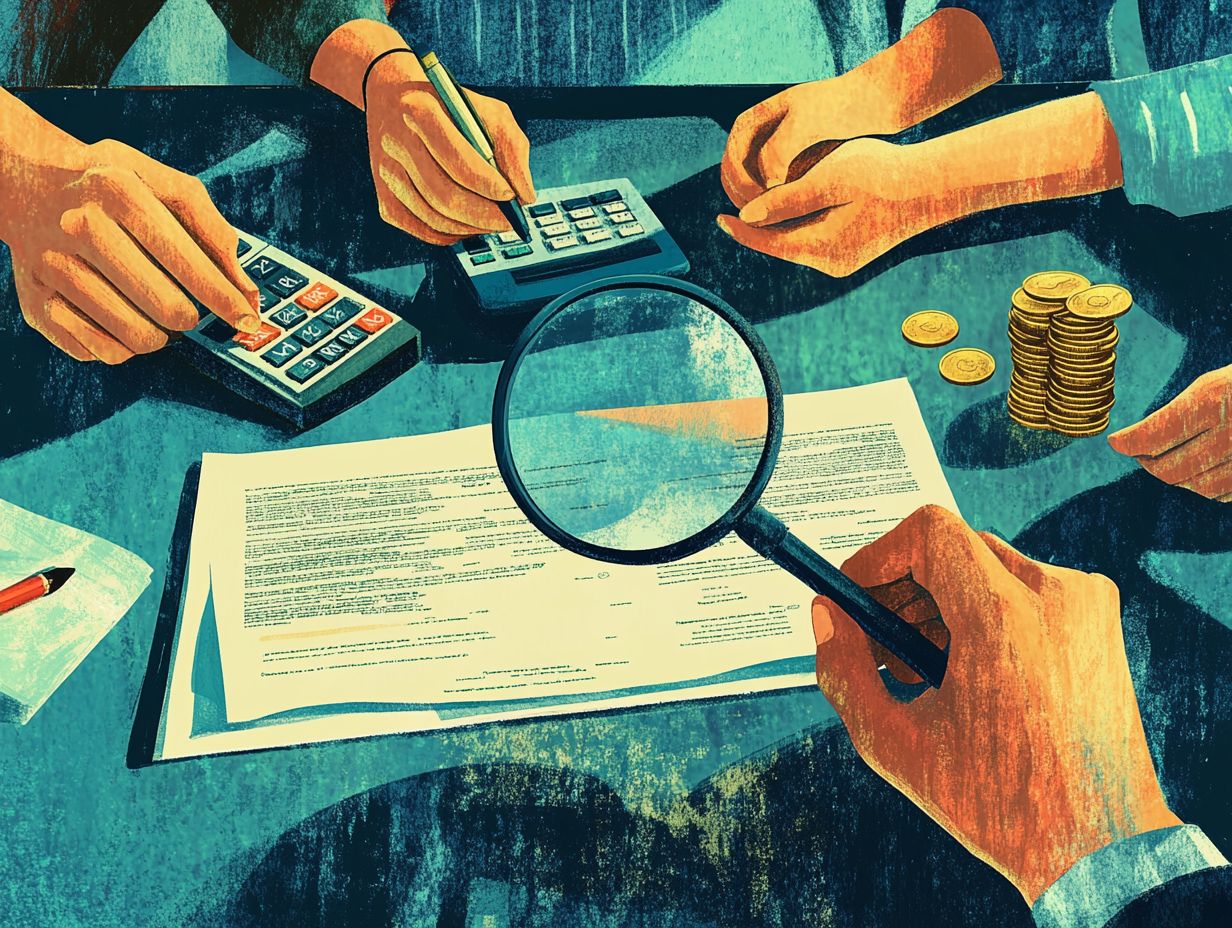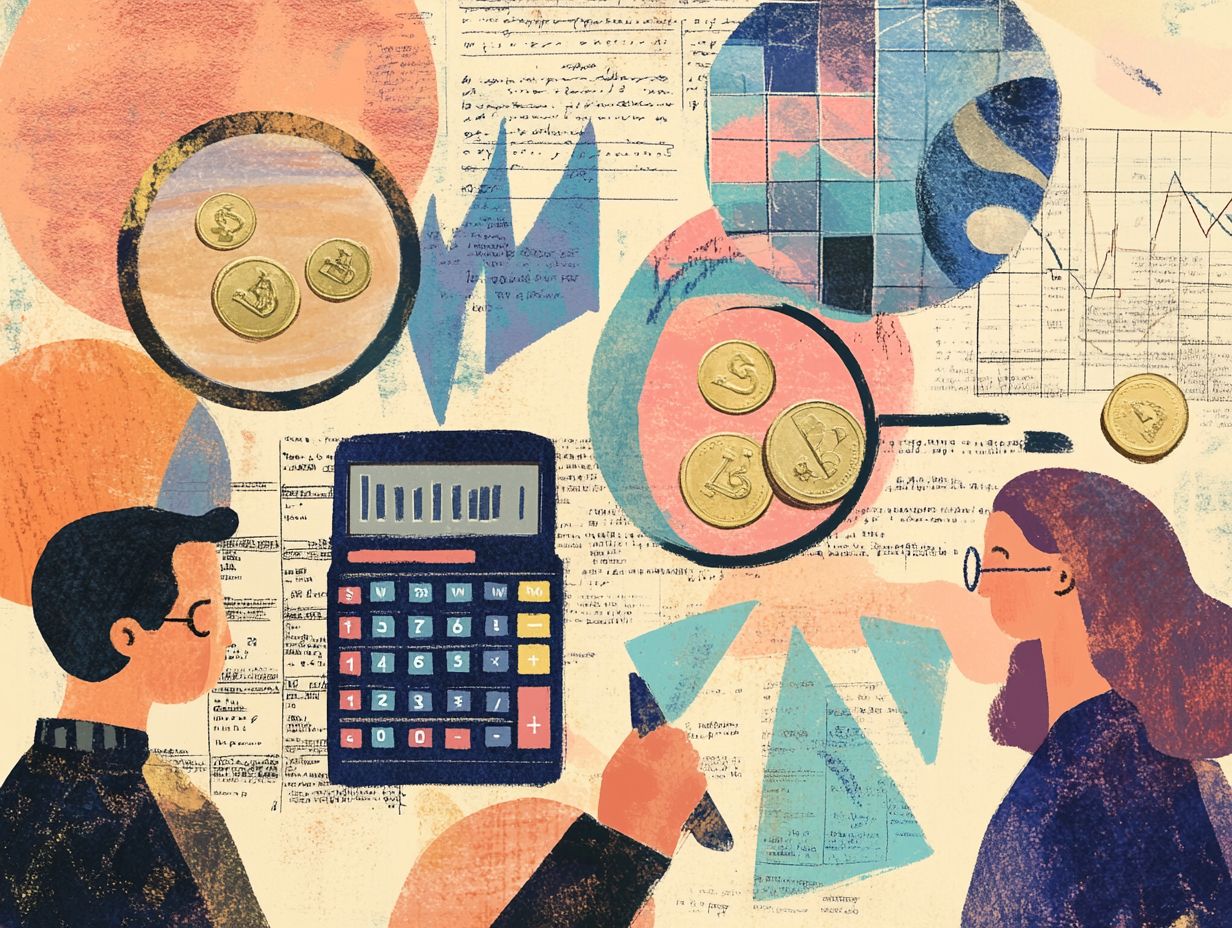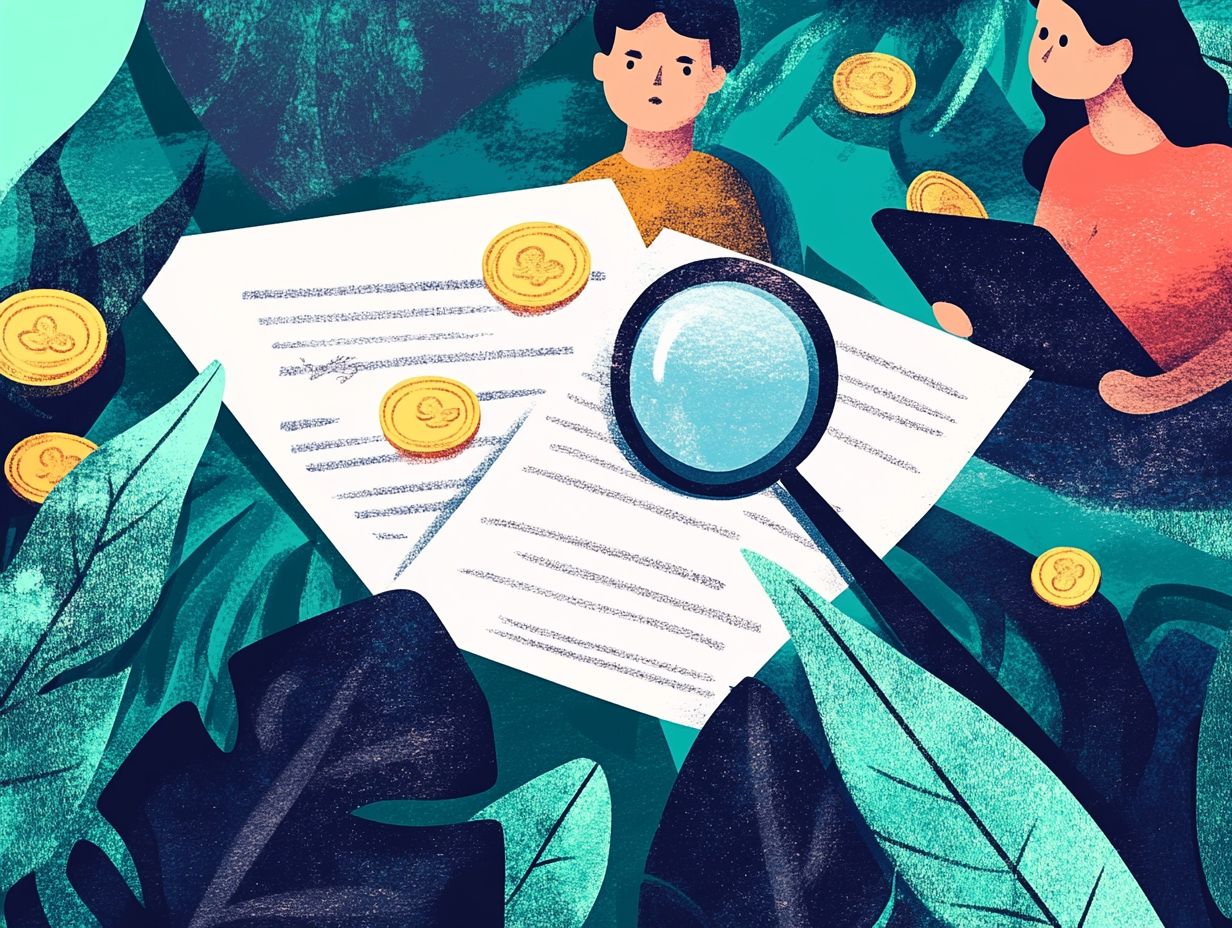5 Challenges in Peer-to-Peer Lending You Should Know
Peer-to-peer lending has emerged as an innovative financial alternative, connecting you directly with investors.
While it offers exciting opportunities, it also presents challenges. From a lack of regulation to the risk of fraud, understanding these hurdles is crucial for anyone considering this lending model.
This article delves into five key challenges that could impact your experience with peer-to-peer lending, alongside insights into its benefits, types, and strategies to mitigate risks.
Get ready to dive into the exciting world of peer-to-peer lending!
Contents
- Key Takeaways:
- 1. Lack of Regulation and Oversight
- 2. Default Risk
- 3. Limited Liquidity
- 4. Potential for Fraud
- 5. Difficulty in Evaluating Borrower Creditworthiness
- What Is Peer-to-Peer Lending and How Does It Work?
- What Are the Benefits of Peer-to-Peer Lending?
- What Are the Different Types of Peer-to-Peer Lending?
- What Are the Key Factors to Consider Before Investing in Peer-to-Peer Lending?
- How Can Investors Mitigate the Risks in Peer-to-Peer Lending?
- What Are the Future Trends and Challenges in Peer-to-Peer Lending?
- Frequently Asked Questions
Key Takeaways:

- Lack of regulation poses risks for investors.
- Diversifying your portfolio is essential to manage default risk.
- Accessing funds can be challenging due to limited liquidity.
1. Lack of Regulation and Oversight
The lack of regulation and oversight in peer-to-peer lending is a significant concern.
Investors and borrowers are exposed to market fluctuations and operational risks without the safety nets that traditional banking provides.
This regulatory gap prompts you to consider some important questions regarding the long-term sustainability of these platforms.
As an investor seeking higher returns, you may suddenly face unforeseen credit risks. Borrowers can default without robust assessment mechanisms in place.
The Bank of England has raised alarms about the systemic risks posed by these unregulated entities, highlighting a potential strain on overall financial stability.
With the recent pandemic amplifying these worries, many borrowers are confronting unprecedented economic challenges. This raises the stakes for lenders like you.
Consequently, the demand for stricter guidelines has increased as stakeholders aim to protect participants while cultivating a trusted environment in the rapidly expanding alternative finance market.
2. Default Risk
Default risk is a crucial consideration in peer-to-peer lending. It influences both your position as an investor and that of the borrower.
This risk fundamentally hinges on credit grades and financial backgrounds, which can significantly affect the appeal of various investment opportunities.
Default risk means the chance that a borrower won’t repay their loan. This can lead to financial losses for you as an investor.
Different types of loans come with varying levels of default risk. For example, personal loans often carry a higher risk compared to secured loans like mortgages.
Credit grades are critical tools for assessing this risk. They provide valuable insights into a borrower s creditworthiness and repayment behavior.
By carefully evaluating these grades, you can make more informed decisions about where to allocate your funds, ultimately enhancing your risk management strategies.
3. Limited Liquidity

Limited liquidity in peer-to-peer lending can present quite the conundrum for you as an investor.
You might find yourself struggling to access your funds promptly due to the lack of a robust secondary market for many investment types.
This limitation could lock you into your commitments for longer than you’d like. This creates a tug-of-war between your immediate cash needs and your long-term investment aspirations.
When the time comes to exit these investments, the scarcity of available buyers can complicate the situation further.
This not only limits your options but could also force you to sell at less-than-ideal prices.
Thus, the secondary market plays a pivotal role in either easing these constraints or worsening liquidity issues.
As a potential investor, grasping these dynamics is crucial when crafting your overall investment strategy.
You need to carefully weigh the potential returns against the risk of being unable to retrieve your capital when you need it.
Explore your options in peer-to-peer lending today and secure your financial future!
4. Potential for Fraud
Beware of potential fraud in Peer-to-Peer lending. Sometimes, the use of new technology can lead to weak credit scoring methods, posing risks for both borrowers and investors. To navigate these challenges effectively, consider these 5 tips for successful peer-to-peer lending.
This environment allows various fraudulent activities, such as identity theft, loan stacking, and misrepresenting financial status.
Credit scoring practices often lag behind advancements in personal finance, allowing people with questionable credit histories to secure funding without proper vetting.
These gaps can lead to defaults, eroding investor confidence and jeopardizing the marketplace’s stability.
Without strong security measures like advanced identity verification and careful transaction monitoring the integrity of these platforms may falter, causing significant financial losses.
5. Difficulty in Evaluating Borrower Creditworthiness
It’s tough to evaluate if borrowers are trustworthy in Peer-to-Peer lending. Credit grading systems often fail to show how well someone can repay a loan, which is why understanding the reasons peer-to-peer lending is here to stay can be beneficial.
The situation is complicated by several factors, including a lack of comprehensive data and the diverse financial behaviors of borrowers. Credit grading often relies on outdated methods that overlook key elements like job stability and spending habits.
As a result, you may face increased risks, such as loan defaults and delays in repayment. These vulnerabilities can compromise your potential returns and highlight the need for a better understanding of borrower profiles.
This deeper insight is crucial for making informed investment decisions and ensuring stability within the lending marketplace.
What Is Peer-to-Peer Lending and How Does It Work?

Peer-to-peer lending is a new alternative finance model that connects you directly with borrowers, using technology to simplify the loan process. This method offers various loan types and investment options, often using methods to assess borrower risk.
This modern lending model has caught your attention for its efficiency and potential to disrupt traditional banking systems. By removing intermediaries, you often enjoy lower interest rates as a borrower and higher returns as an investor.
The online platforms use advanced algorithms to match you with suitable lenders, creating a smooth transaction experience. However, while this model presents significant opportunities, it also carries risks.
As an investor, you might encounter borrower defaults, while as a borrower, you could face unexpected fees or terms. Understanding these dynamics, along with popular use cases for peer-to-peer lending, is essential as you navigate this evolving financial landscape.
What Are the Benefits of Peer-to-Peer Lending?
Peer-to-Peer lending offers many advantages, including a variety of investment options and increased financial access for borrowers who might not qualify for traditional loans. However, it’s important to understand how to navigate risks in peer-to-peer lending to make informed decisions.
As an investor, you can often enjoy attractive returns that help diversify your income. This innovative financial model not only makes loans more accessible for borrowers but also allows you to achieve higher returns compared to usual investment options.
By connecting individuals directly, Peer-to-Peer lending breaks down the barriers often found in traditional banking. This opens doors for those often overlooked by conventional banks.
As a result, a diverse pool of borrowers can secure the funding they need, while you have the chance to support meaningful projects and earn competitive returns.
What Are the Different Types of Peer-to-Peer Lending?
You ll find various Peer-to-Peer lending options available, including consumer loans, business loans, real estate financing, and education loans.
Each type offers unique investment opportunities tailored to different borrower needs and investor preferences.
Consumer loans help individuals afford big purchases or consolidate debt. They attract investors looking for steady returns.
Business loans provide entrepreneurs with the capital they need to expand their ventures. These loans may appeal to those willing to take on more risk for potentially higher returns.
Real estate financing supports property investments, drawing in investors who are interested in the real estate market but want to be cautious of its volatility.
Education loans focus on students pursuing their degrees. These loans offer a reliable repayment schedule that appeals to socially responsible investors eager to support future generations.
Each loan category comes with its own risk profile, helping you align your investment choices with your financial goals seamlessly.
What Are the Key Factors to Consider Before Investing in Peer-to-Peer Lending?

Before diving into Peer-to-Peer lending, it’s essential to consider several factors. Look at the borrower’s ability to repay, potential platform fees, and the specific loan types you’re interested in. Additionally, be aware of the common misconceptions about peer-to-peer lending, as these elements are crucial in determining the risk and reward of your investment.
When assessing a borrower’s ability to repay, pay close attention to their credit scores, payment history, and current financial obligations. These indicators can give you insight into the likelihood of repayment.
Know the fees involved with the lending platform, as they can significantly impact your overall returns. Even small fees can reduce your profits over time.
Be aware of the types of loans personal, business, or student loans. Understanding these can help you match your comfort level with how much risk you re willing to take.
How Can Investors Mitigate the Risks in Peer-to-Peer Lending?
You can effectively manage the risks of Peer-to-Peer lending by using some key strategies.
First, think about spreading your investments across multiple loans. This approach reduces the chance that a single default will heavily impact your overall returns.
Understanding a borrower’s credit profile is also vital. Take the time to analyze their credit scores, income levels, and repayment history. These factors are crucial for assessing potential risks.
Exploring different loan types personal, business, or real estate allows you to take a more strategic approach to managing risk. Each type has its own unique profile, and being informed enables you to make decisions that fit your financial goals.
What Are the Future Trends and Challenges in Peer-to-Peer Lending?
Peer-to-Peer lending is changing due to new trends and challenges. It’s important to be aware of the risks of peer-to-peer lending as financial technology evolves, impacting both investors and borrowers.
Innovations like blockchain and AI will enhance transparency and speed up transactions. This creates a more efficient lending environment.
The rise of mobile platforms makes it easier for individuals to join these lending networks. This broadens the pool of potential lenders and borrowers.
However, as these platforms grow, they face regulatory scrutiny and competition from traditional banks. This could impact their market position.
You must adapt to these changes to ensure sustainable alternative finance in this fast-paced landscape.
Frequently Asked Questions
What is peer-to-peer lending?
Peer-to-peer lending, or P2P lending, allows individuals or businesses to borrow money directly from others instead of banks.
What are five key challenges in peer-to-peer lending? The main challenges are credit risk, platform risk, liquidity risk, regulatory risk, and technology risk.
How does credit risk affect peer-to-peer lending?
Credit risk is the chance that borrowers may not repay their loans. Since P2P lenders may not evaluate borrowers as strictly as banks do, the likelihood of default increases, leading to potential losses for lenders.
What is platform risk in peer-to-peer lending?
Platform risk refers to concerns about the stability and reliability of the lending platform itself. If a platform fails or goes bankrupt, it can negatively affect both lenders and borrowers.
How does liquidity risk affect peer-to-peer lending?
Liquidity risk arises when borrowers default or withdraw funds before loans are fully repaid. This can limit the funds available for lenders to invest in new loans, delaying returns or causing losses.
What is regulatory risk in peer-to-peer lending?
Regulatory risk involves potential changes in government regulations that could impact the P2P lending industry, affecting platform operations and profitability.
How does technology risk impact peer-to-peer lending?
Technology risk includes issues like website crashes or security breaches that can disrupt lending operations, potentially leading to financial losses for both lenders and borrowers.
Stay ahead! The landscape of Peer-to-Peer lending is evolving quickly, and you need to adapt. Discover 5 reasons to invest in Peer-to-Peer lending to learn more about how to navigate this dynamic market.






